Assessing Potential Bioenergy Production on Urban Marginal Land in 20 Major Cities of China by the Use of Multi-View High-Resolution Remote Sensing Data
Abstract
:1. Introduction
2. Materials and Methods
2.1. Study Areas
2.2. Data
2.3. Urban Marginal Land Estimation
3. Results
3.1. Accuracy Assessment
3.2. Marginal Land Resources in the 20 Cities of China
3.3. Bioenergy Potential in the 20 Cities of China
3.4. Landscape Patterns of Marginal Land
4. Discussion
4.1. Development of Biofuels in China
4.2. Practical Considerations of Urban Marginal Land
5. Conclusions
Author Contributions
Funding
Institutional Review Board Statement
Informed Consent Statement
Data Availability Statement
Acknowledgments
Conflicts of Interest
References
- Jiang, D.; Hao, M.; Fu, J.; Zhuang, D.; Huang, Y. Spatial-temporal variation of marginal land suitable for energy plants from 1990 to 2010 in China. Sci. Rep. 2014, 4, 5816. [Google Scholar] [CrossRef] [Green Version]
- Qin, Z.; Zhuang, Q.; Cai, X.; He, Y.; Huang, Y.; Jiang, D.; Lin, E.; Liu, Y.; Tang, Y.; Wang, M.Q. Biomass and biofuels in China: Toward bioenergy resource potentials and their impacts on the environment. Renew. Sust. Energy Rev. 2018, 82, 2387–2400. [Google Scholar] [CrossRef]
- Tang, Y.; Xie, J.-S.; Geng, S. Marginal land-based biomass energy production in China. J. Int. Plant Biol. 2010, 52, 112–121. [Google Scholar] [CrossRef] [PubMed]
- Hassan, M.H.; Kalam, M.A. An Overview of Biofuel as a Renewable Energy Source: Development and Challenges. Procedia Eng. 2013, 56, 39–53. [Google Scholar] [CrossRef] [Green Version]
- Li, X.; Huang, Y.; Gong, J.; Zhang, X. A study of the development of bio-energy resources and the status of eco-society in China. Energy 2010, 35, 4451–4456. [Google Scholar] [CrossRef]
- Balat, M.; Balat, H. Recent trends in global production and utilization of bio-ethanol fuel. Appl. Energy 2009, 86, 2273–2282. [Google Scholar] [CrossRef]
- Jiang, D.; Zhuang, D.; Fu, J.; Huang, Y.; Wen, K. Bioenergy potential from crop residues in China: Availability and distribution. Renew. Sust. Energy Rev. 2012, 16, 1377–1382. [Google Scholar] [CrossRef]
- Feng, Q.; Chaubey, I.; Engel, B.; Cibin, R.; Sudheer, K.P.; Volenec, J. Marginal land suitability for switchgrass, Miscanthus and hybrid poplar in the Upper Mississippi River Basin (UMRB). Environ. Model. Softw. 2017, 93, 356–365. [Google Scholar] [CrossRef] [Green Version]
- Renewables 2018 Global Status Report. Available online: http://www.ren21.net/status-of-renewables/global-status-report/ (accessed on 13 March 2019).
- Cobuloglu, H.I.; Büyüktahtakın, İ.E. Food vs. biofuel: An optimization approach to the spatio-temporal analysis of land-use competition and environmental impacts. Appl. Energy 2015, 140, 418–434. [Google Scholar] [CrossRef]
- Liu, T.; Huffman, T.; Kulshreshtha, S.; McConkey, B.; Du, Y.; Green, M.; Liu, J.; Shang, J.; Geng, X. Bioenergy production on marginal land in Canada: Potential, economic feasibility, and greenhouse gas emissions impacts. Appl. Energy 2017, 205, 477–485. [Google Scholar] [CrossRef]
- Niblick, B.; Landis, A.E. Assessing renewable energy potential on United States marginal and contaminated sites. Renew. Sust. Energy Rev. 2016, 60, 489–497. [Google Scholar] [CrossRef] [Green Version]
- Gelfand, I.; Sahajpal, R.; Zhang, X.; Izaurralde, R.C.; Gross, K.L.; Robertson, G.P. Sustainable bioenergy production from marginal lands in the US Midwest. Nature 2013, 493, 514–517. [Google Scholar] [CrossRef]
- Milbrandt, A.R.; Heimiller, D.M.; Perry, A.D.; Field, C.B. Renewable energy potential on marginal lands in the United States. Renew. Sust. Energy Rev. 2014, 29, 473–481. [Google Scholar] [CrossRef]
- Glithero, N.J.; Wilson, P.; Ramsden, S.J. Optimal combinable and dedicated energy crop scenarios for marginal land. Appl. Energy 2015, 147, 82–91. [Google Scholar] [CrossRef]
- Saha, M.; Eckelman, M.J. Geospatial assessment of regional scale bioenergy production potential on marginal and degraded land. Resour. Conserv. Recycl. 2018, 128, 90–97. [Google Scholar] [CrossRef]
- Xue, S.; Lewandowski, I.; Wang, X.; Yi, Z. Assessment of the production potentials of Miscanthus on marginal land in China. Renew. Sust. Energy Rev. 2016, 54, 932–943. [Google Scholar] [CrossRef]
- Zhuang, D.; Jiang, D.; Liu, L.; Huang, Y. Assessment of bioenergy potential on marginal land in China. Renew. Sust. Energy Rev. 2011, 15, 1050–1056. [Google Scholar] [CrossRef]
- Edrisi, S.A.; Abhilash, P.C. Exploring marginal and degraded lands for biomass and bioenergy production: An Indian scenario. Renew. Sust. Energy Rev. 2016, 54, 1537–1551. [Google Scholar] [CrossRef]
- Cai, X.; Zhang, X.; Wang, D. Land availability for biofuel production. Environ. Sci. Technol. 2010, 45, 334–339. [Google Scholar] [CrossRef] [PubMed]
- Feng, Q.; Chaubey, I.; Cibin, R.; Engel, B.; Sudheer, K.P.; Volenec, J.; Omani, N. Perennial biomass production from marginal land in the Upper Mississippi River Basin. Land Degrad. Dev. 2018, 29, 1748–1755. [Google Scholar] [CrossRef]
- Kammen, D.M.; Sunter, D.A. City-integrated renewable energy for urban sustainability. Science 2016, 352, 922–928. [Google Scholar] [CrossRef] [Green Version]
- Kraxner, F.; Aoki, K.; Kindermann, G.; Leduc, S.; Albrecht, F.; Liu, J.; Yamagata, Y. Bioenergy and the city–What can urban forests contribute? Appl. Energy 2016, 165, 990–1003. [Google Scholar] [CrossRef]
- Grewal, P.S.; Grewal, P.S. Can cities become self-reliant in energy? A technological scenario analysis for Cleveland, Ohio. Cities 2013, 31, 404–411. [Google Scholar] [CrossRef]
- Madlener, R.; Bachhiesl, M. Socio-economic drivers of large urban biomass cogeneration: Sustainable energy supply for Austria’s capital Vienna. Energy Policy 2007, 35, 1075–1087. [Google Scholar] [CrossRef]
- Comber, A.; Dickie, J.; Jarvis, C.; Phillips, M.; Tansey, K. Locating bioenergy facilities using a modified GIS-based location–allocation-algorithm: Considering the spatial distribution of resource supply. Appl. Energy 2015, 154, 309–316. [Google Scholar] [CrossRef] [Green Version]
- Zhao, X.; Monnell, J.D.; Niblick, B.; Rovensky, C.D.; Landis, A.E. The viability of biofuel production on urban marginal land: An analysis of metal contaminants and energy balance for Pittsburgh’s Sunflower Gardens. Landsc. Urban. Plan. 2014, 124, 22–33. [Google Scholar] [CrossRef]
- Saha, M.; Eckelman, M.J. Geospatial assessment of potential bioenergy crop production on urban marginal land. Appl. Energy 2015, 159, 540–547. [Google Scholar] [CrossRef]
- Niblick, B.; Monnell, J.D.; Zhao, X.; Landis, A.E. Using geographic information systems to assess potential biofuel crop production on urban marginal lands. Appl. Energy 2013, 103, 234–242. [Google Scholar] [CrossRef]
- Yang, Z.; Cai, J.; Sliuzas, R. Agro-tourism enterprises as a form of multi-functional urban agriculture for peri-urban development in China. Habitat Int. 2010, 34, 374–385. [Google Scholar] [CrossRef]
- McClintock, N.; Mahmoudi, D.; Simpson, M.; Santos, J.P. Socio-spatial differentiation in the Sustainable City: A mixed-methods assessment of residential gardens in metropolitan Portland, Oregon, USA. Landsc. Urban. Plan. 2016, 148, 1–16. [Google Scholar] [CrossRef] [Green Version]
- Jiang, D.; Hao, M.; Fu, J.; Liu, K.; Yan, X. Potential bioethanol production from sweet sorghum on marginal land in China. J. Clean Prod. 2019, 220, 225–234. [Google Scholar] [CrossRef]
- Wang, F.; Shi, X. Geospatial analysis for utilizing the marginal land in regional biofuel industry: A case study in Guangdong Province, China. Biomass Bioenergy 2015, 83, 302–310. [Google Scholar] [CrossRef]
- Nie, Y.; Cai, W.; Wang, C.; Huang, G.; Ding, Q.; Yu, L.; Li, H.; Ji, D. Assessment of the potential and distribution of an energy crop at 1-km resolution from 2010 to 2100 in China–The case of sweet sorghum. Appl. Energy 2019, 239, 395–407. [Google Scholar] [CrossRef]
- Arodudu, O.; Ibrahim, E.; Voinov, A.; van Duren, I. Exploring bioenergy potentials of built-up areas based on NEG-EROEI indicators. Ecol. Indic. 2014, 47, 67–79. [Google Scholar] [CrossRef] [Green Version]
- Van Meerbeek, K.; Ottoy, S.; De Meyer, A.; Van Schaeybroeck, T.; Van Orshoven, J.; Muys, B.; Hermy, M. The bioenergy potential of conservation areas and roadsides for biogas in an urbanized region. Appl. Energy 2015, 154, 742–751. [Google Scholar] [CrossRef]
- Huang, X.; Wang, Y. Investigating the effects of 3D urban morphology on the surface urban heat island effect in urban functional zones by using high-resolution remote sensing data: A case study of Wuhan, Central China. ISPRS J. Photogram. Remote Sens. 2019, 152, 119–131. [Google Scholar] [CrossRef]
- Huang, X.; Wen, D.; Li, J.; Qin, R. Multi-level monitoring of subtle urban changes for the megacities of China using high-resolution multi-view satellite imagery. Remote Sens. Environ. 2017, 196, 56–75. [Google Scholar] [CrossRef]
- Huang, X.; Wang, Y.; Li, J.; Chang, X.; Cao, Y.; Xie, J.; Gong, J. High-resolution urban land-cover mapping and landscape analysis of the 42 major cities in China using ZY-3 satellite images. Sci Bull. 2020, 65, 1039–1048. [Google Scholar] [CrossRef]
- Liu, C.; Huang, X.; Wen, D.; Chen, H.; Gong, J. Assessing the quality of building height extraction from ZiYuan 3 multi view imagery. Remote Sens. Lett. 2017, 8, 907–916. [Google Scholar] [CrossRef]
- China Land Use/Cover Datasets. Available online: http://www.resdc.cn/ (accessed on 30 January 2019).
- Kuang, W.; Liu, J.; Dong, J.; Chi, W.; Zhang, C. The rapid and massive urban and industrial land expansions in China between 1990 and 2010: A CLUD-based analysis of their trajectories, patterns, and drivers. Landsc. Urban. Plan. 2016, 145, 21–33. [Google Scholar] [CrossRef]
- Geographical Information Monitoring Cloud Platform. Available online: http://www.dsac.cn/ (accessed on 5 February 2019).
- China Soil Database. Available online: http://vdb3.soil.csdb.cn/ (accessed on 20 January 2019).
- ASTER Global Digital Elevation Model. Available online: https://earthexplorer.usgs.gov/ (accessed on 1 November 2019).
- Arefi, H.; Reinartz, P. Accuracy Enhancement of ASTER Global Digital Elevation Models Using ICESat Data. Remote Sens. 2011, 3, 1323–1343. [Google Scholar] [CrossRef] [Green Version]
- Huang, X.; Cai, Y.F.; Li, J. Evidence of the mitigated urban particulate matter island (UPI) effect in China during 2000–2015. Sci. Total Environ. 2019, 660, 1327–1337. [Google Scholar] [CrossRef] [PubMed]
- Li, H.; Lian, Y.; Wang, X.; Ma, W.; Zhao, L. Solar constant values for estimating solar radiation. Energy 2011, 36, 1785–1789. [Google Scholar] [CrossRef]
- Lyons, M.B.; Keith, D.A.; Phinn, S.R.; Mason, T.J.; Elith, J. A comparison of resampling methods for remote sensing classification and accuracy assessment. Remote Sens. Environ. 2018, 208, 145–153. [Google Scholar] [CrossRef]
- McGarigal, K. FRAGSTATS HELP. Available online: http://www.umass.edu/landeco/research/fragstats/documents/fragstats.help.4.2.pdf (accessed on 14 March 2019).
- Su, S.; Hu, Y.N.; Luo, F.; Mai, G.; Wang, Y. Farmland fragmentation due to anthropogenic activity in rapidly developing region. Agric. Syst. 2014, 131, 87–93. [Google Scholar] [CrossRef]
- Liang, C.; Penghui, J.; Wei, C.; Manchun, L.; Liyan, W.; Yuan, G.; Yuzhe, P.; Nan, X.; Yuewei, D.; Qiuhao, H. Farmland protection policies and rapid urbanization in China: A case study for Changzhou City. Land Use Policy 2015, 48, 552–566. [Google Scholar] [CrossRef]
- Jansson, C.; Westerbergh, A.; Zhang, J.; Hu, X.; Sun, C. Cassava, a potential biofuel crop in (the) People’s Republic of China. Appl. Energy 2009, 86, S95–S99. [Google Scholar] [CrossRef]
- Tian, Y.; Zhao, L.; Meng, H.; Sun, L.; Yan, J. Estimation of un-used land potential for biofuels development in (the) People’s Republic of China. Appl. Energy 2009, 86, S77–S85. [Google Scholar] [CrossRef]
- Chen, W.; Wu, F.; Zhang, J. Potential production of non-food biofuels in China. Renew. Energy 2016, 85, 939–944. [Google Scholar] [CrossRef]
- Wang, Y.; Bi, Y.; Tang, J. Progress and development trend of China’s energy crop research. Forum Sci. Technol. China 2009, 3, 124–128. [Google Scholar]
- Yinchuan Statistical Yearbook—2018. Available online: http://tjj.yinchuan.gov.cn/tjsj/ndsj/201902/P020190219544999835664.pdf (accessed on 23 March 2019).
- Middle- and Long-Term Development Plan for Renewable Energy in China. Available online: http://www.sdpc.gov.cn/fzgggz/fzgh/ghwb/gjjgh/200709/P020150630514238979659.pdf (accessed on 21 May 2019).
- Peidong, Z.; Yanli, Y.; Yongsheng, T.; Xutong, Y.; Yongkai, Z.; Yonghong, Z.; Lisheng, W. Bioenergy industries development in China: Dilemma and solution. Renew. Sust. Energy Rev. 2009, 13, 2571–2579. [Google Scholar] [CrossRef]
- 12th Five-Year Renewable Energy Strategic Plan. Available online: http://www.nea.gov.cn/2013-01/28/c_132132808.htm (accessed on 26 July 2019).
- Qiu, H.; Sun, L.; Huang, J.; Rozelle, S. Liquid biofuels in China: Current status, government policies, and future opportunities and challenges. Renew. Sust. Energy Rev. 2012, 16, 3095–3104. [Google Scholar] [CrossRef]
- Zhong, C.; Cao, Y.-X.; Li, B.-Z.; Yuan, Y.-J. Biofuels in China: Past, present and future. Biofuels, Bioprod Bioref 2010, 4, 326–342. [Google Scholar] [CrossRef]
- Wang, Q. Time for commercializing non-food biofuel in China. Renew. Sust. Energy Rev. 2011, 15, 621–629. [Google Scholar] [CrossRef]
- Qiu, H.; Huang, J.; Yang, J.; Rozelle, S.; Zhang, Y.; Zhang, Y.; Zhang, Y. Bioethanol development in China and the potential impacts on its agricultural economy. Appl. Energy 2010, 87, 76–83. [Google Scholar] [CrossRef]
- Wan, N.F.; Cai, Y.M.; Shen, Y.J.; Ji, X.Y.; Wu, X.W.; Zheng, X.R.; Cheng, W.; Li, J.; Jiang, Y.P.; Chen, X.; et al. Increasing plant diversity with border crops reduces insecticide use and increases crop yield in urban agriculture. Elife 2018, 7, e35103. [Google Scholar] [CrossRef]
- Shi, Y.; Ge, Y.; Chang, J.; Shao, H.; Tang, Y. Garden waste biomass for renewable and sustainable energy production in China: Potential, challenges and development. Renew. Sust. Energy Rev. 2013, 22, 432–437. [Google Scholar] [CrossRef]
- Guiding Opinions of the National Development and Reform Commission on the Development of Modern Metropolitan Area. Available online: http://www.gov.cn/xinwen/2019-02/21/content_5367465.htm (accessed on 30 July 2019).
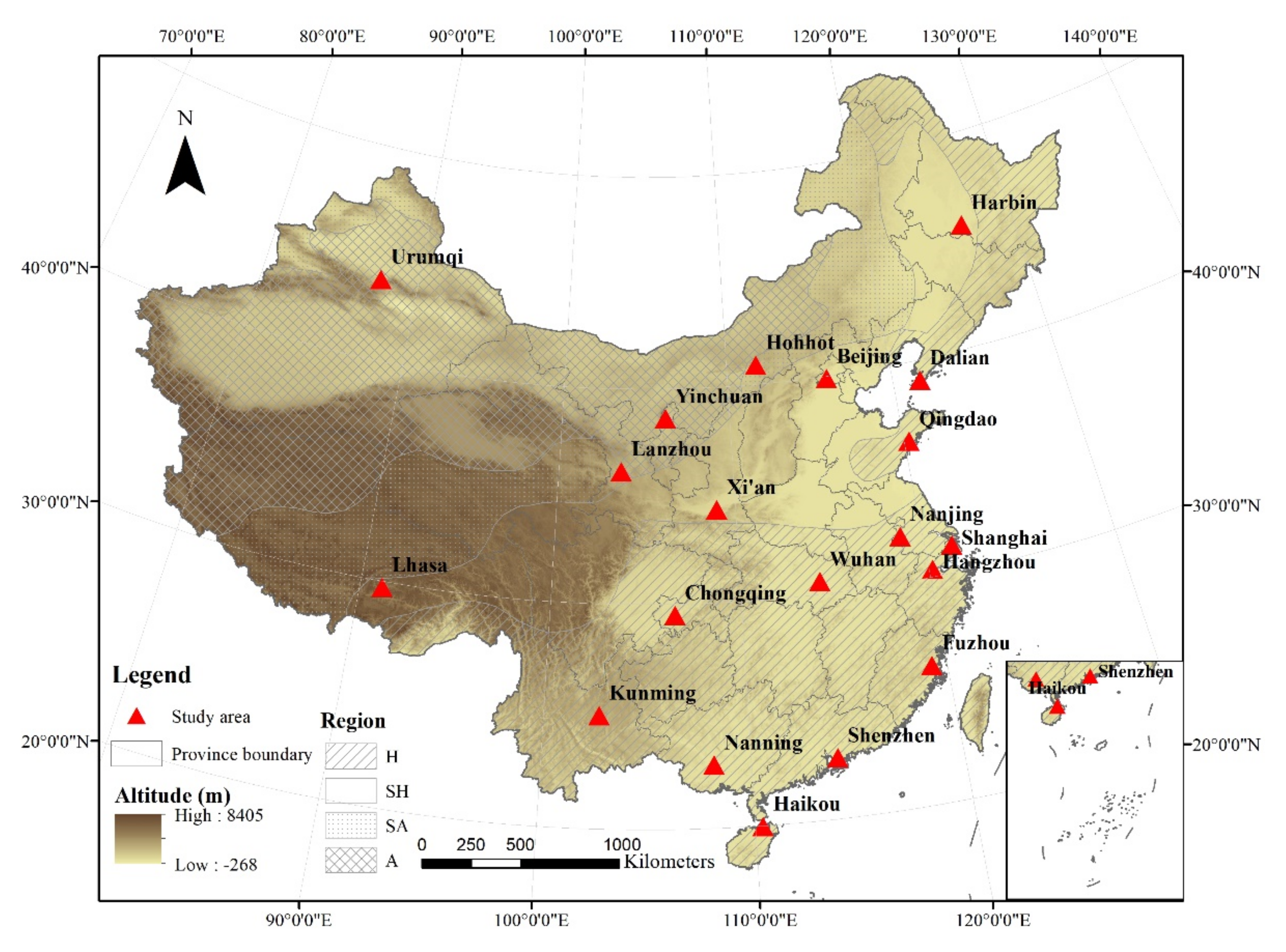
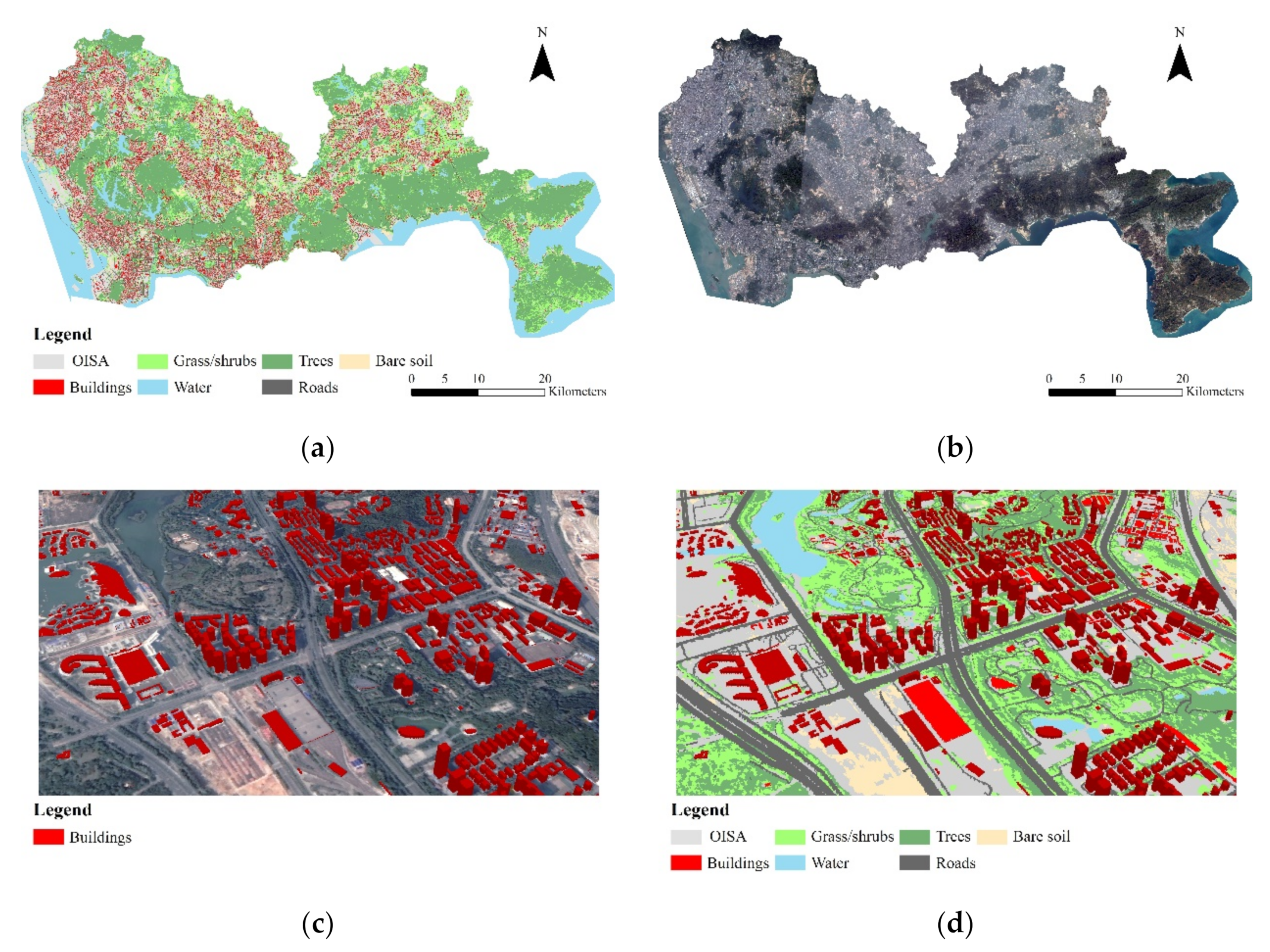
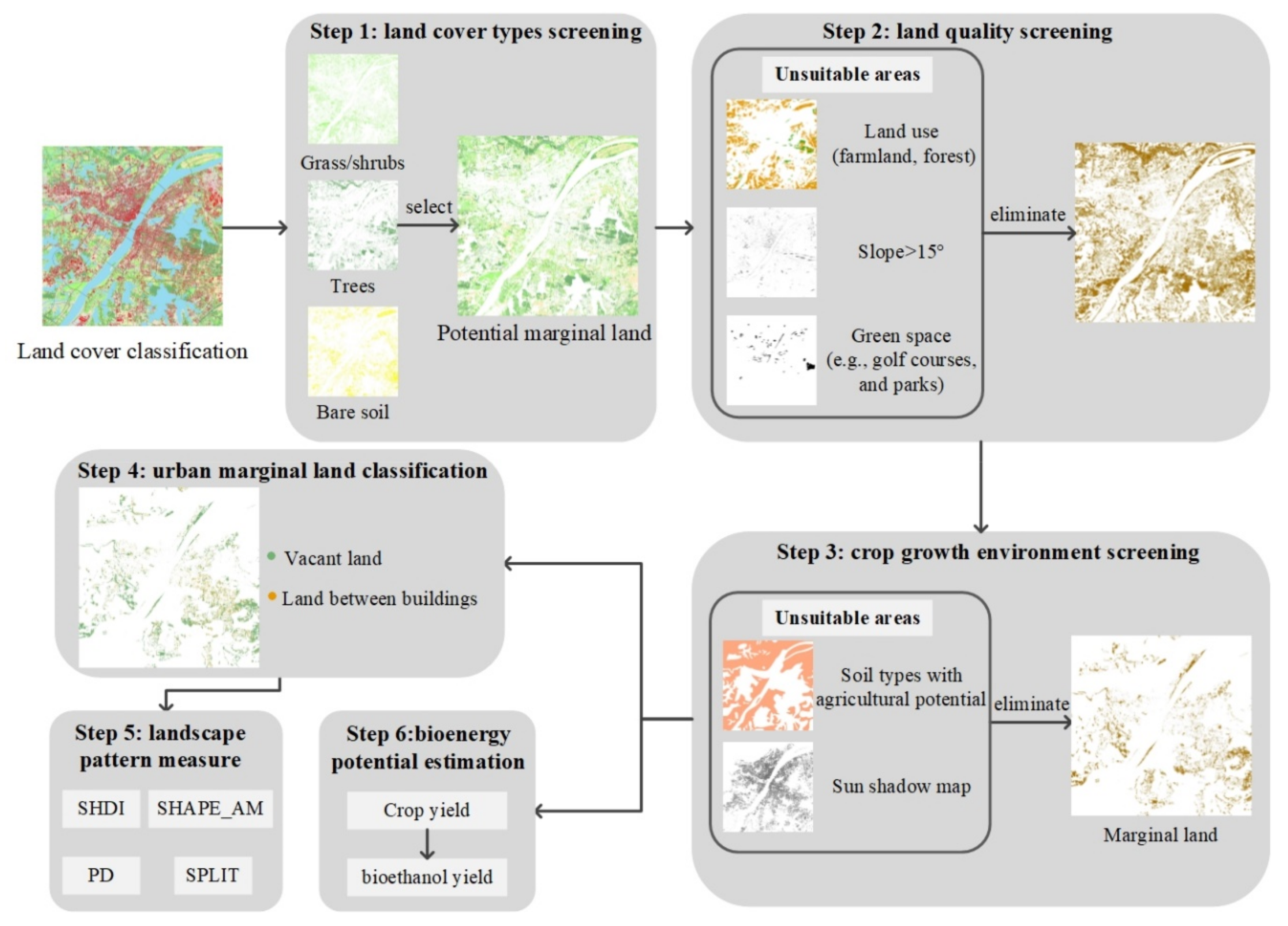
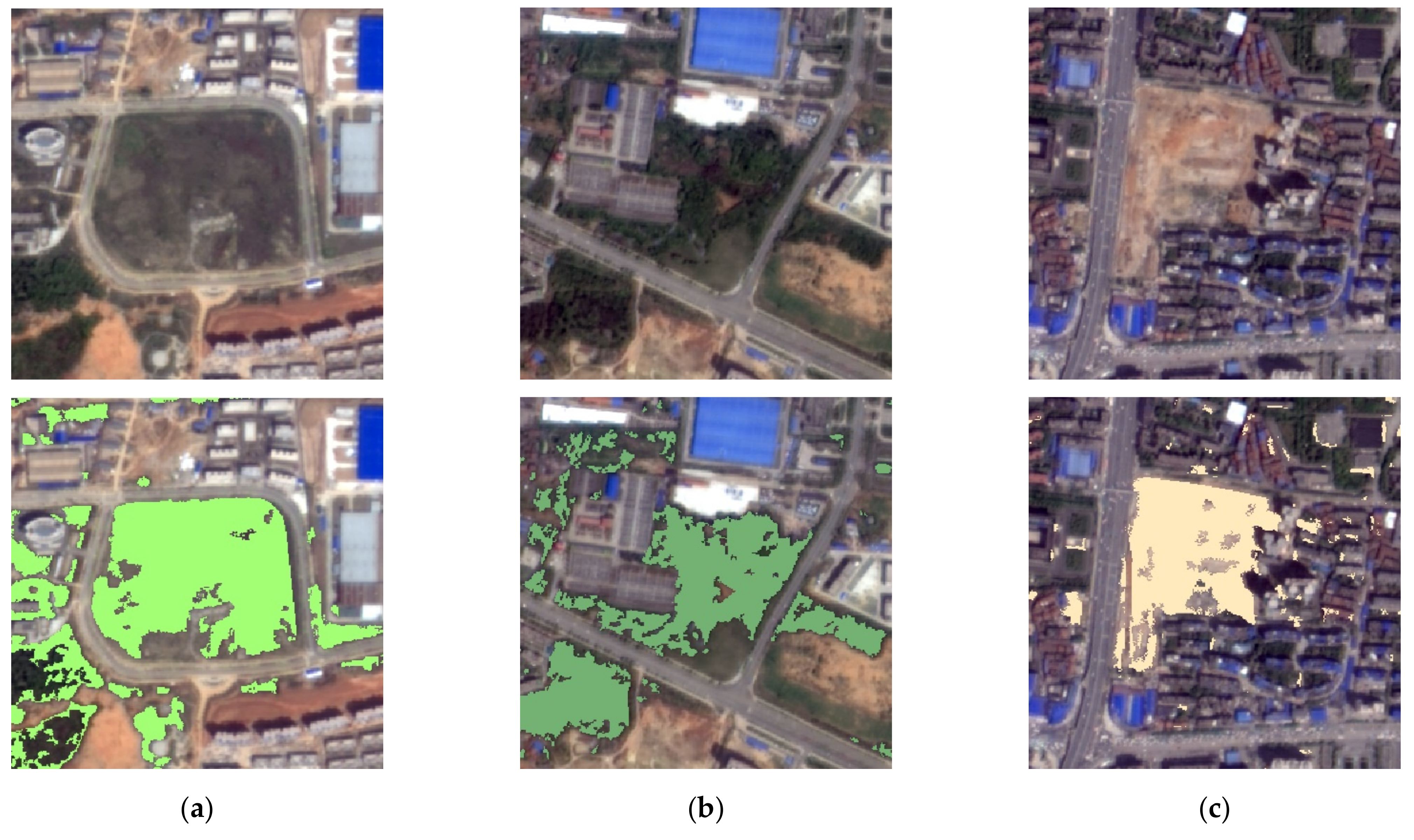
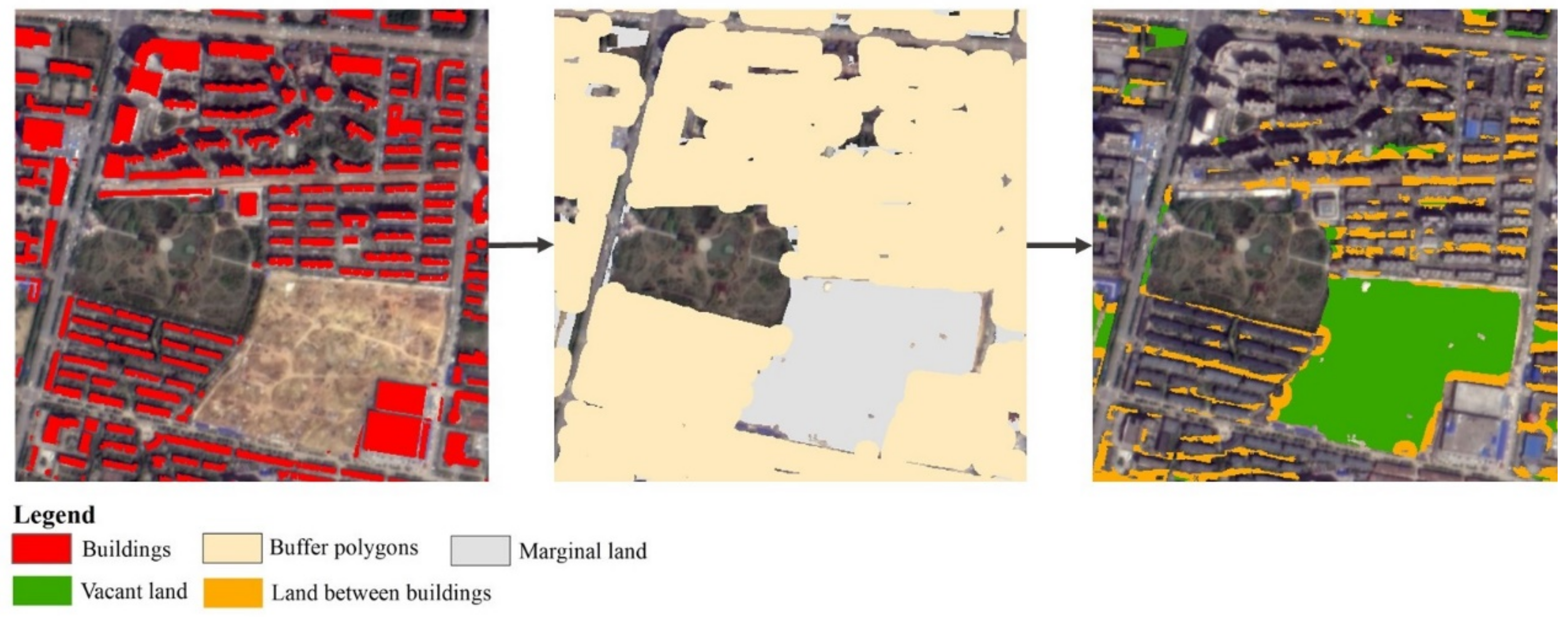
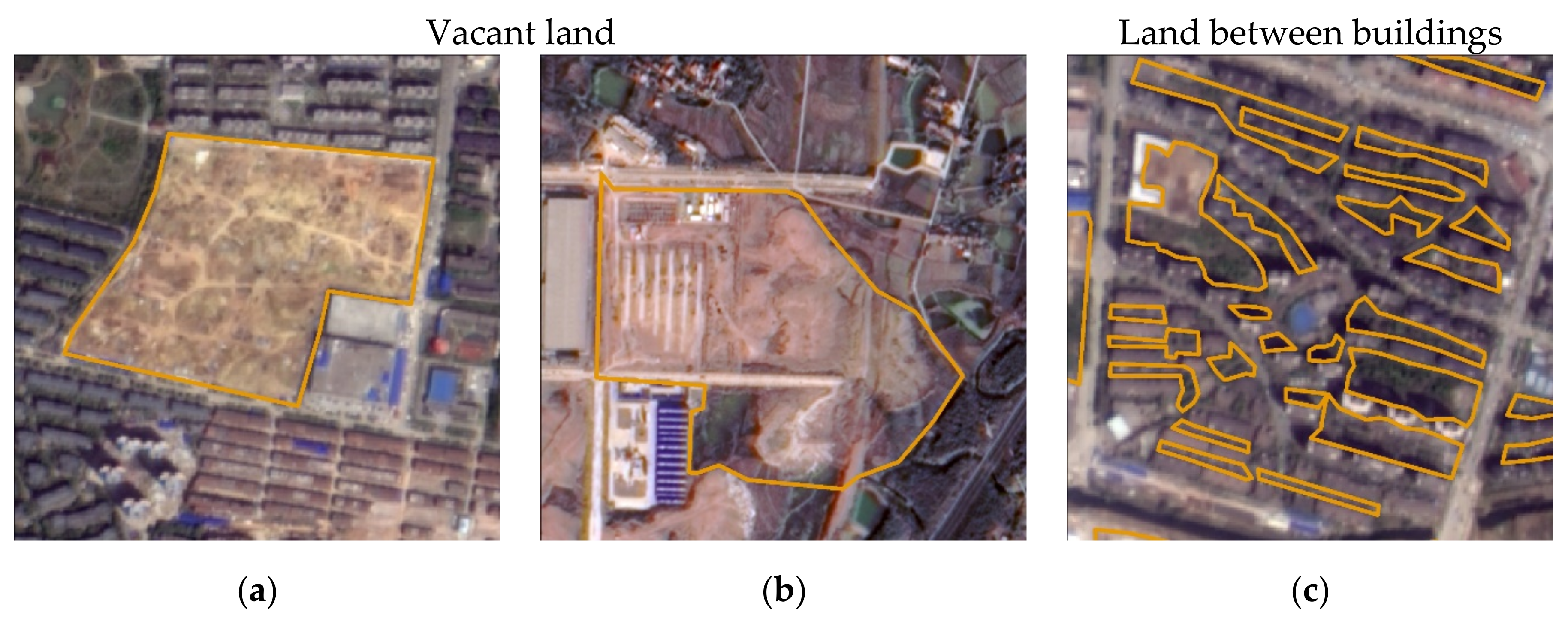
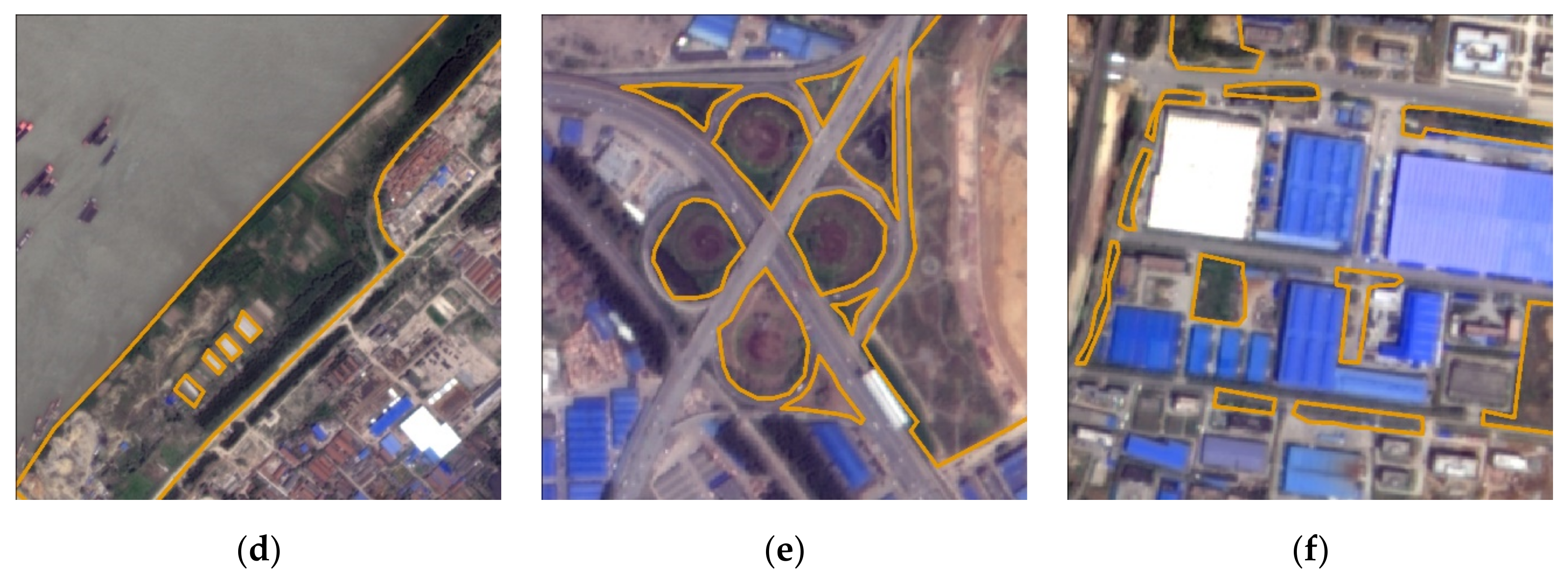


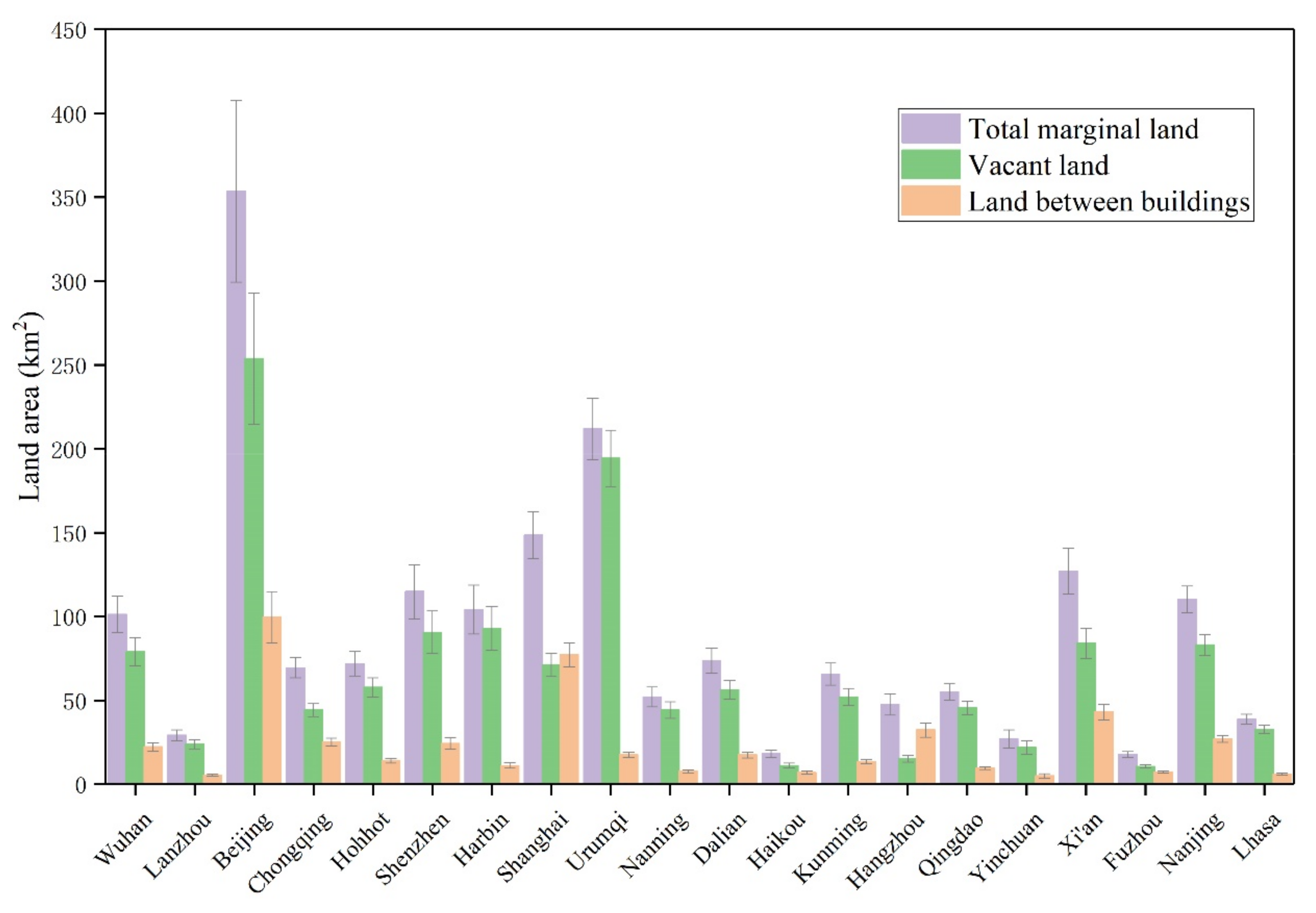
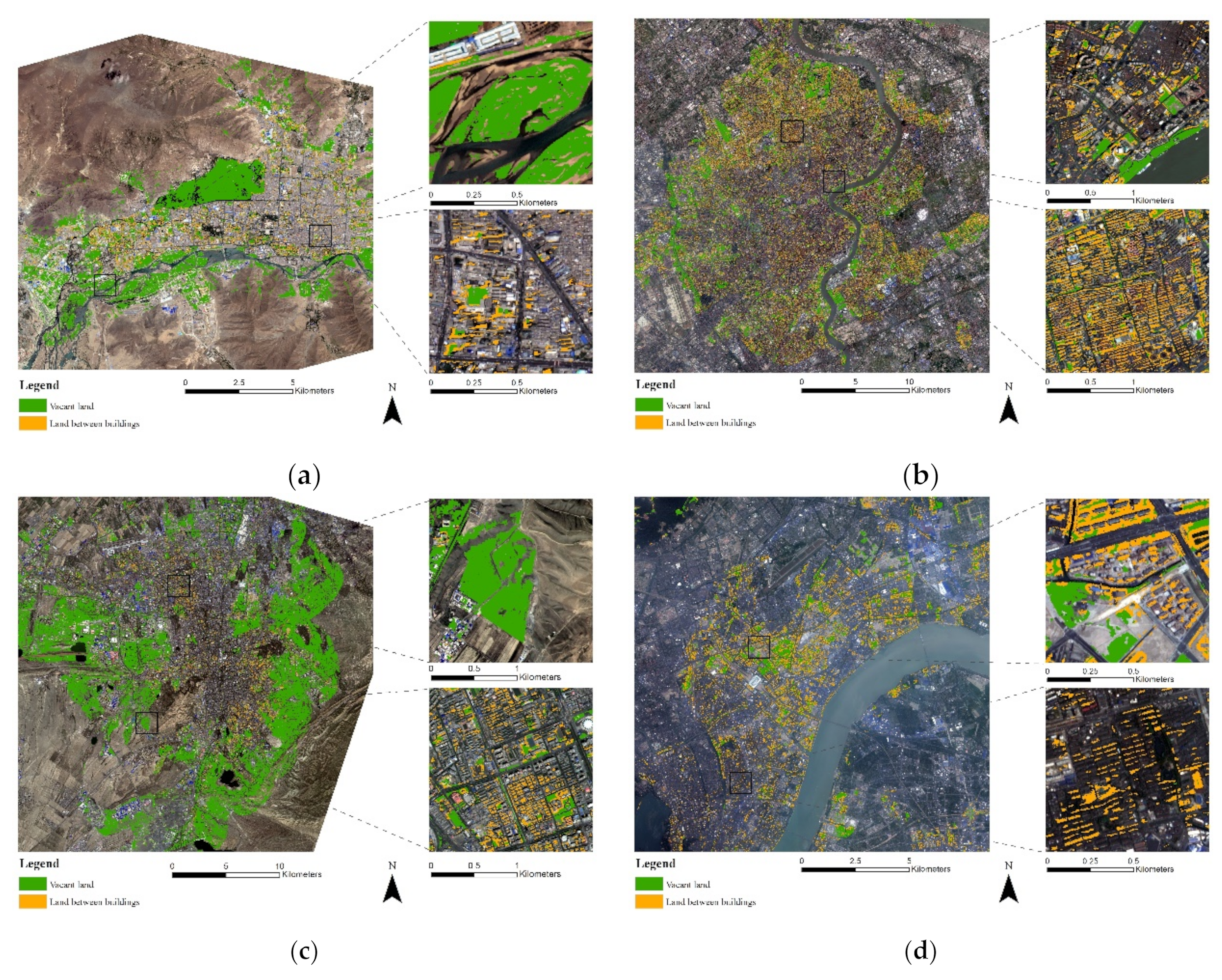
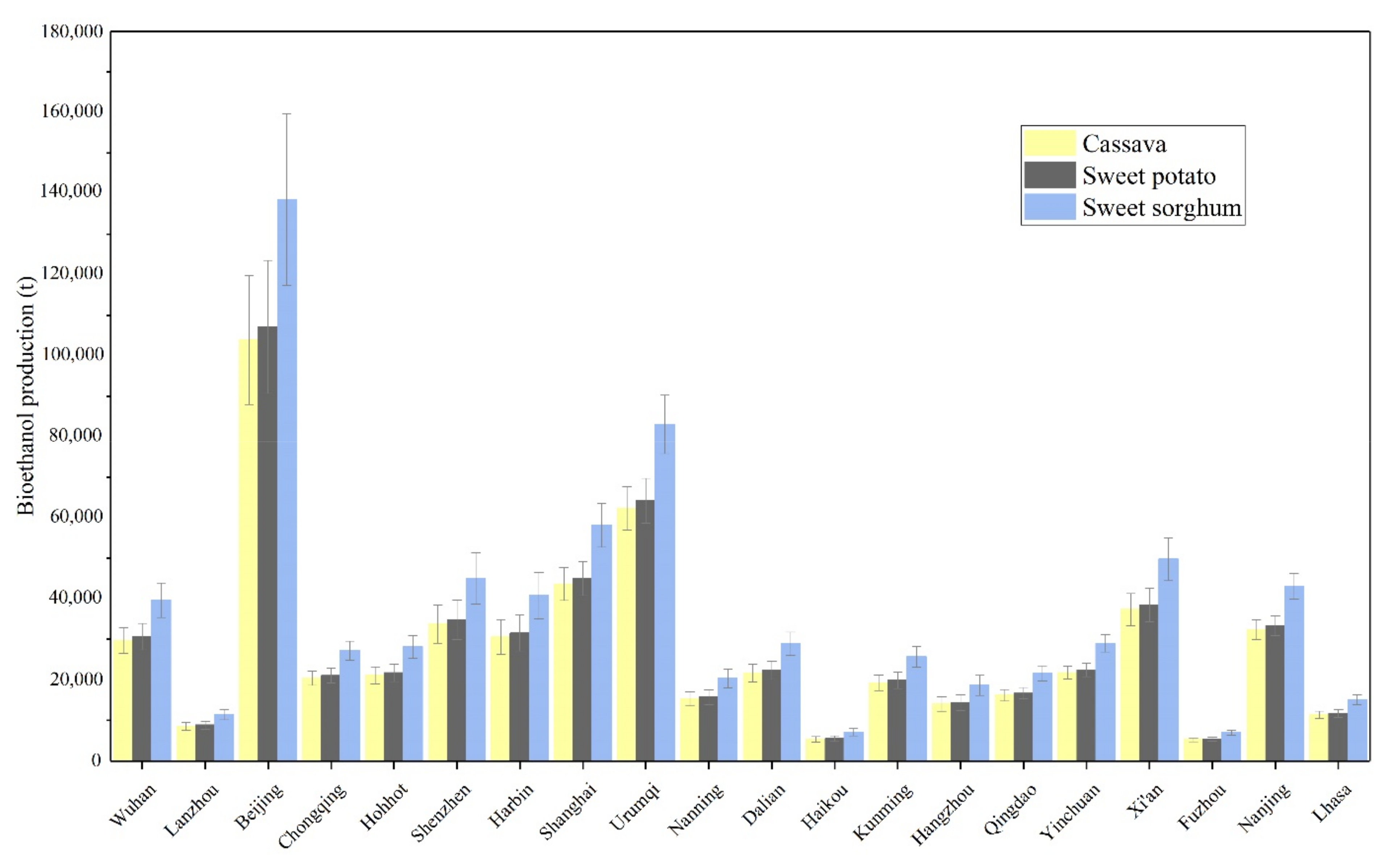
| Data | Resolution | Date | |
|---|---|---|---|
| ZY-3 3D land-cover products | Land-cover classification | 2.1 m | 2014–2017 |
| Building height | 2.1 m | 2014–2017 | |
| Pan-sharpened images | 2.1 m | 2014–2017 | |
| Ancillary geographical information dataset | Land-use classification | 30 m | 2015 |
| Soil classification | Vector | 2017 | |
| DEM | 30 m | 2017 |
| Index | Abbreviation | Definition | |
|---|---|---|---|
| Shannon’s diversity index | SHDI | m = number of patch types. = proportion of the landscape occupied by patch type i. | |
| Area-weighted mean shape index | SHAPE_AM | m = number of patch types. n = number of patches of type i. = perimeter (m) of patch ij. = area (m2) of patch ij. A = total landscape area (m2). | |
| Patch density | PD | n = number of all the patches in the landscape. A = total landscape area (m2) | |
| Splitting index | SPLIT | m = number of patch types. n = number of patches of type i. = area (m2) of patch ij. A = total landscape area (m2). | |
| Energy Crop | Crop Yield (t/hm2) | Ethanol Production per Unit Area (t/ hm2) |
|---|---|---|
| Cassava | 25.11 | 2.94 |
| Sweet potato | 24.20 | 3.03 |
| Sweet sorghum | 60.00 | 3.92 |
| City | SHDI | SHAPE_AM | PD | SPLIT |
|---|---|---|---|---|
| Wuhan | 0.5268 | 3.8641 | 256.3316 | 505.0575 |
| Lanzhou | 0.4763 | 4.4051 | 306.7608 | 315.1415 |
| Beijing | 0.5948 | 3.1431 | 309.2137 | 3201.0624 |
| Chongqing | 0.6546 | 3.1383 | 369.7685 | 1056.9696 |
| Hohhot | 0.4956 | 4.9510 | 207.4825 | 203.0184 |
| Shenzhen | 0.5158 | 3.0814 | 361.8865 | 1221.6038 |
| Harbin | 0.3412 | 5.3815 | 317.0489 | 511.8621 |
| Shanghai | 0.6923 | 3.4665 | 439.3523 | 1073.1278 |
| Urumqi | 0.2861 | 11.0431 | 169.8163 | 76.6271 |
| Nanning | 0.5120 | 3.3161 | 351.3262 | 606.9387 |
| Dalian | 0.5478 | 3.5638 | 480.6290 | 855.0483 |
| Haikou | 0.6653 | 2.6049 | 782.4346 | 614.8317 |
| Kunming | 0.5093 | 3.2013 | 431.5100 | 820.6415 |
| Hangzhou | 0.6270 | 3.1013 | 537.3208 | 1557.683 |
| Qingdao | 0.5884 | 4.7296 | 258.4764 | 371.8006 |
| Yinchuan | 0.5644 | 3.7721 | 262.9526 | 958.5792 |
| Xi’an | 0.6403 | 3.1353 | 357.5116 | 1465.1117 |
| Fuzhou | 0.6766 | 3.3440 | 543.6591 | 201.6644 |
| Nanjing | 0.5564 | 3.5715 | 309.0620 | 1002.6987 |
| Lhasa | 0.4317 | 5.0551 | 200.6853 | 50.8254 |
Publisher’s Note: MDPI stays neutral with regard to jurisdictional claims in published maps and institutional affiliations. |
© 2021 by the authors. Licensee MDPI, Basel, Switzerland. This article is an open access article distributed under the terms and conditions of the Creative Commons Attribution (CC BY) license (https://creativecommons.org/licenses/by/4.0/).
Share and Cite
Zhang, B.; Yang, J.; Cao, Y. Assessing Potential Bioenergy Production on Urban Marginal Land in 20 Major Cities of China by the Use of Multi-View High-Resolution Remote Sensing Data. Sustainability 2021, 13, 7291. https://doi.org/10.3390/su13137291
Zhang B, Yang J, Cao Y. Assessing Potential Bioenergy Production on Urban Marginal Land in 20 Major Cities of China by the Use of Multi-View High-Resolution Remote Sensing Data. Sustainability. 2021; 13(13):7291. https://doi.org/10.3390/su13137291
Chicago/Turabian StyleZhang, Ben, Jie Yang, and Yinxia Cao. 2021. "Assessing Potential Bioenergy Production on Urban Marginal Land in 20 Major Cities of China by the Use of Multi-View High-Resolution Remote Sensing Data" Sustainability 13, no. 13: 7291. https://doi.org/10.3390/su13137291
APA StyleZhang, B., Yang, J., & Cao, Y. (2021). Assessing Potential Bioenergy Production on Urban Marginal Land in 20 Major Cities of China by the Use of Multi-View High-Resolution Remote Sensing Data. Sustainability, 13(13), 7291. https://doi.org/10.3390/su13137291






